
Image Credit: Pixabay, Our Better World
Spotted In India: Humans And Leopards Living In Harmony
Writer: Our Better World
Our Better World is the digital storytelling initiative of the Singapore International Foundation, which brings world communities together to do good.
India, 12 Aug 2021 7:56 AM GMT
Creatives : Kishan Rao A S |
He believes in the philosophy of it is not a race to win but to create his own track. He has his opinions and realizes that every day is a learning.
Guest Author : Our Better World
Our Better World is the digital storytelling initiative of the Singapore International Foundation, which brings world communities together to do good.
A (big) cat’s fight for coexistence with humans gets a boost from conservation NGO Titli Trust.
Imagine a stray cat or dog rooting through the rubbish bin in your garden for discarded food scraps. It is a mess, a nuisance, but perhaps not especially alarming.
Now imagine if something else shows up: a wild leopard, attracted by the strays that were drawn to your food scraps. And the leopard is also eyeing up your livestock or pet dog with far more interest than you'd like.
For thousands of Indians living on the edges of forests where leopards are known to dwell, these encounters are an everyday occurrence. And these encounters occasionally claim lives.
In 2020, leopards killed 35 people in the state of Maharashtra, the highest in a decade. Further north, in the state of Uttarakhand, as of October 2020, leopard attacks had claimed 24 lives, a sharp 30 per cent increase from the previous year.
These clashes often lead to leopards being killed or captured and released elsewhere away from human settlements, despite research indicating that these methods do not reduce the number of attacks. In some cases, translocation has led to increased attacks.
"The thing is that the conflict is an old one, [but] the method to treat the conflict hasn't really changed," says Sanjay Sondhi, founder of Titli Trust, a nature conservation non-profit based in Uttarakhand.
This prompted conservationists to ask: what if the focus on human-wildlife conflict shifted from wildlife to humans?
Spotted in the backyard
India is home to more than 12,000 Indian leopards; only the African continent has more of these big cats. Even with a recent population rebound, their numbers are a tenth of what it was a century ago, due to poaching and habitat loss.
These adaptable big cats can be found all over India and can live close to villages, towns and cities with ease, preying on wildlife, livestock and stray animals alike.
Meena Devi recalls the time a leopard entered her home in Mulnow, a village in Tehri district, Uttarakhand. "Two times actually, it came into my home. One time it killed my sheep, the other time my dog," says Meena, a farmer and shop owner.
News that a leopard was in the vicinity would spark alarm. "There was a sense of fear in the village," she shares.
Incidents like these were a common issue Titli Trust came across in its work with local communities, so the Trust decided to dive deeper.
"It so happens one of our friends [is] Dr Vidya Athreya, one of the premier researchers and experts on leopards in India," shares Sanjay. "We wanted to do something that would reduce the conflict and she had the expertise, and that's how we came together to work on this issue."
A Senior Scientific Director at Wildlife Conservation Society India (WCS-India), Dr Athreya's research in Maharashtra had led her to collaborate with the state's forest department to start Mumbaikars for SGNP, a programme that sees citizens lead the way in engaging the community on learning to live safely alongside leopards.
"We were very impressed by the work, and we saw that there was no reason why we can't replicate this in our state [Uttarakhand]," says Sanjay.
Despite the long history of leopard-human conflict in Uttarakhand, Sanjay was encouraged by the findings of a survey on attitudes towards leopards, which was conducted with Dr Athreya.
"People were very tolerant towards leopards. Uttarakhand is a hill state and people have grown up with wild animals throughout their lives," he points out.
Human behaviour in the spotlight
In 2017, Titli Trust began working with Tehri Forest Division to arm the local community — with knowledge — through a programme dubbed Living with Leopards.
Supported by the Trust and Uttarakhand Forest Department, the forest officials and community stakeholders like village elders made a study trip to Mumbai to learn from their experiences there.
"The discussions post our Mumbai trip has taught us that we need to shift the focus from leopards to people," says Dr Koko Rose from the Tehri Forest Division. "It is easier to focus on people than to focus on the leopard."
This meant reaching out to villagers to share about measures they could take to minimise the chances of a leopard encounter or attack. They include clearing bushes and overgrowth around homes to minimise hiding spaces for leopards, leaving a light on at night to deter them, and ensuring people, especially children, did not go out alone at night.
The strategies, simple as they sound, are carefully aimed at a leopard's known habits: they are shy, tend to avoid human beings, and are more active at night.
The villagers were also taught what to do when they encounter leopards — to give way to the leopard and move away calmly, and to alert the forest department immediately.
With support from the Trust, forest officials also went to schools and launched a children's ambassador programme, where children dressed up as leopards and performed for their parents plays that created more understanding of why leopards come near their homes, and how to stay safe.
These efforts, says Meena, have helped her understand the importance of being vigilant. "When we keep our surroundings clean, be alert, then we needn't be afraid. The leopards cross my shop many times, but when we do not bother them, they keep going on their own path."
In the four years before the programme started in 2017, there were 45 cases of human-leopard conflict in the Tehri area, among them 10 human deaths. In the four years after, the number of cases went down to 14, four of them involving human deaths.
"Our ancestors tell us how they have lived in the forests, grazed the animals in the forests, but the leopard has never attacked them," says Meena. "So we too can live [with leopards], if we remain vigilant and follow the rules."
Keeping up a constant flow of communication and education with the community is a role that falls largely on the shoulders of forest division officials like Koko.
When attacks happen and people are hurt or killed, "there's a lot of anger", he acknowledges. "Sometimes it's difficult to talk conservation. But we tried to tell people removing one leopard does not finish the problem. Another leopard comes and occupies that territory."
Koko and his team did not always handle these situations with such confidence. Lacking the equipment and expertise needed to deal with reports of leopard sightings and attacks, the division was reliant on rescue teams from surrounding national parks — the closest being six hours away. Trapped animals died in distress while awaiting rescue, affecting the community's trust in the officers' abilities to handle their calls for help.
With Titli Trust providing training, Koko and his colleagues set up rapid response teams to better respond to calls in a way that was safe for both humans and leopards. Their success has led to invitations from other forest divisions to share their expertise.
"Titli Trust has been a very reliable partner for us. They've provided us access to ideas and people. They have helped us immensely, especially in the community outreach programme...taking the pain to plan and organise the awareness materials," says Koko.
He adds: "I think they're instrumental to the success of our story here."
Sanjay believes that to sustain such programmes, involving all stakeholders in the community is crucial. In another district in Uttarakhand, the programme did not see notable change in the situation, because the idea was not fully embraced by the community, he notes.
Koko is also wary of celebrating too soon. "In spite of the lower numbers of conflict that we have seen in the last four years, the fact [is] that four people died," he says soberly. "Somebody died or somebody had to face the trauma of an animal attack.
"It gives us hope that our incidences are decreasing. But I think we still have a long way to go."
In time, Sanjay hopes all stakeholders can come together to help other communities learn to live with wildlife harmoniously. "I think we humans forget that we are just another species, and just as we have the right to live on planet Earth, so does the leopard, so does the tiger and the ants and butterflies and moths.
"The fact is not whether we perceive them as having an ecological role. I think they have the right to live in homes that have been theirs for a lot longer than ours."
Though the idea of living with leopards may seem challenging to increasingly urbanised attitudes, Sanjay suggests that people may simply be returning to cultural roots by doing so. "In Indian culture, especially in Hindu culture, there is a great deal of tolerance towards wildlife. There are many animals and creatures that are worshipped as lords and gods in our religion, and that makes people extremely tolerant towards wildlife.
So I think Living with Leopards programme in India is not a difficult thing for people to adopt because culturally, that's how all of us have been brought up."
This story first appeared on Our Better World's wildlife series.
Also Read: Transgender Persons Face Maximum Discrimination From Family: Study
 All section
All section















